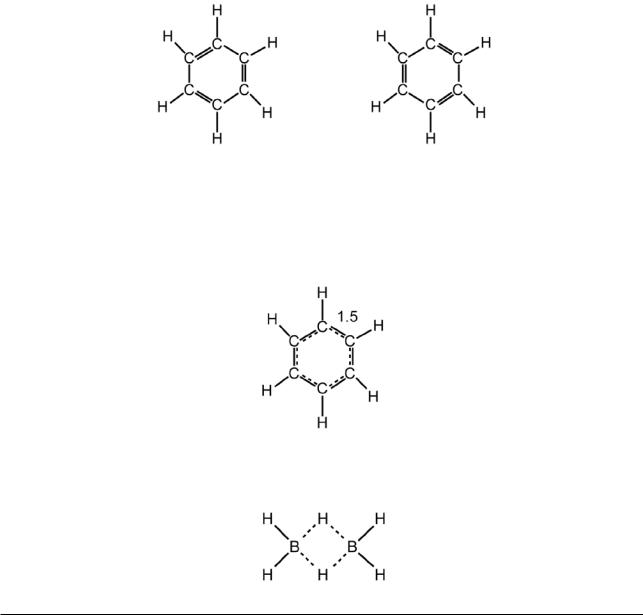
introduction-to-inorganic-chemistry
.pdf
Introduction to Inorganic Chemistry |
Classification of elements according to the electrochemical series |
|
|
Elements forming more than one stable cation or anion can be used if the correct ion can be identified. For example, oxygen forms several anions. These are O2− (if oxides like Na2O are completely ionic) and anions containing O−O bonds (e.g. O22−). Compounds containing the latter give H2O2 with acid. If no H2O2 is formed, the appropriate ion is O2−. Similarly, sulfur forms S2− and anions containing S−S bonds (e.g. S22−). Compounds containing the latter give sulfur with acid. Iodine forms I− and I3−. Compounds containing I3− give brown solutions in water.
The charges on the ions when a compound is written in its hypothetical ionic form are called the “polar numbers” or “oxidation numbers” of the elements concerned. Thus the polar number of carbon in CCl4 is +4 and of chlorine –1. “Polar number” is the original term and somewhat more expressive than “oxidation number”: but the latter is now used almost universally.
Exercise
What are the oxidation numbers of the elements in each of the following compounds?
(i)Methane, CH4.
(ii)Iron dichloride, FeCl2.
(iii)Sodium hydride, NaH.
(iv)Silicon dioxide, SiO2.
(v)Carbonyl chloride, COCl2.
(vi)Hydroxylamine, NH2OH.
(vii)Hydrogen peroxide, H2O2.
(viii)Silicon carbide, SiC.
(Click here for answers http://bit.ly/hIoKBI or see Appendix 1)
7.5 Nomenclature of binary compounds
Binary compounds are named by citing the name of the electropositive constituent first, unmodified, followed by the name of the electronegative constituent, modified to end in -ide. For this purpose, an agreed series is used, based on the electrochemical series given above.
Examples: |
sodium chloride |
|
hydrogen sulfide |
Download free ebooks at bookboon.com
61

Introduction to Inorganic Chemistry |
Classification of elements according to the electrochemical series |
|
|
In a small number of cases, when the name of the element has to be modified, the Latin name is used.
|
Copper |
Cuprum |
|
Gold |
Aurum |
|
Iron |
Ferrum |
|
Lead |
Plumbum |
|
Silver |
Argentum |
|
Tin |
Stannum |
Example: |
sodium plumbide |
|
The proportions of the constituents may be indicated in one of the following ways:
(i) By means of Greek numerical prefixes (mono, di, tri, tetra, penta, hexa, etc.). The prefix mono is omitted except where confusion would arise.
Example: |
iron dichloride |
(ii) By means of the oxidation numbers of the elements where these are not obvious, indicated by a Roman numeral placed immediately following the name of the element (without a space).
Example: |
iron(II) chloride |
(Note that when an oxidation number is used with the symbol for an atom of an element, it is placed as a superscript without brackets, e.g. FeII.)
(iii) In the case of genuinely ionic compounds, the proportions may be indicated by means of the charges on the ions where these are not obvious, indicated by an Arabic numeral followed by the sign of the charge placed in parentheses immediately following the name of the ion (without a space).
Example: |
iron(2+) chloride |
An older method that was used to indicate the proportions when a metal forms two series of compounds, based on two different cations (e.g. Fe2+ and Fe3+), was to alter the name of the metal to end in -ous for the lower series and -ic for the higher, e.g.
FeCl2 |
ferrous chloride |
FeCl3 |
ferric chloride |
This method has the merit of elegance, but is now disfavoured.
Download free ebooks at bookboon.com
62

Introduction to Inorganic Chemistry |
Classification of elements according to the electrochemical series |
|
|
Exercise
Name the following compounds:
(i)SnCl4;
(ii)OF2;
(iii)Mg2Sn.
(Click here for answers http://bit.ly/hBK3gd or see Appendix 1)
Further reading
The nomenclature given above is that recommended by the Commission on the Nomenclature of Inorganic Chemistry of the International Union of Pure and Applied Chemistry (IUPAC). This is set out in:
G.J. Leigh (editor), Nomenclature of Inorganic Chemistry: Recommendations 1990, Blackwell, Oxford, 1990.
Please click the advert
Download free ebooks at bookboon.com
63

Introduction to Inorganic Chemistry |
Valency |
|
|
8 Valency
The valency of an element is a number, or set of numbers, from which the formulae of many of its compounds can be derived. Metallic compounds are excluded, since the formulae of these cannot generally be rationalized in this kind of way.
8.1 Ordinary valency
The valency (V) of an atom may be defined as the number of hydrogen or fluorine atoms with which the atom will combine. The assumption is made that hydrogen and fluorine are always univalent.
To obtain the number of hydrogen or fluorine atoms (X) with which an atom (A) will combine, one looks at compounds formed between A and X, and picks out the one in which there are no A−A bonds. If this is molecular it will have the formula AXn, if non-molecular (AXn)∞. The valency of A is then given by n.
When neither hydrogen nor fluorine is suitable for the determination of valency, other atoms can be used, provided that their valencies have first been established relative to hydrogen or fluorine. The most useful is the oxygen atom, though this must be employed with care, for the following reasons:
(i)since oxygen is bivalent, the simplest molecules formed between A and O may be of the type A2On, and one has to be certain that these do not contain A–A bonds;
(ii)one also has to be certain that any molecules considered do not contain peroxo groups, -O–O-;
(iii)oxygen is sometimes capable of forming molecules of types that are not paralleled by any formed by univalent elements (e.g. CO).
The valencies of some of the more important elements are given in the Table at the end of this chapter. For some elements there is only one valency; for others there are several. These valencies enable bond formulae to be drawn for many molecules of the elements concerned, as is done routinely in organic chemistry.
Notes
(i)When an element has more than one valency, there may be some ambiguity in drawing the bond formulae of some of its compounds unless further details are known. For example, since sulfur has valencies of 2, 4, and 6, the sulfur dioxide molecule could be formulated as (I) or (II):
Download free ebooks at bookboon.com
64

Introduction to Inorganic Chemistry |
Valency |
|
|
Formula (II) is accepted because sulfur dioxide does not behave like a peroxide, and microwave spectroscopy gives the O–S–O angle as 119.5º and the S–O distance as 1.43 Å. The latter is similar to the distance in molecules that have to be written with a double SO bond, e.g. 1.45 Å in SOCl2. Three-membered rings, with angles of 60°, are unusual in molecules.
(ii)Even for atoms having a single valency, there can be a choice of structure. For example, the oxide
of a quadrivalent element (A) can have a molecular structure with double bonds (e.g. CO2), a framework structure with single bonds (e.g. SiO2), a chain structure with both single and double bonds (e.g. SeO2), or a framework structure with fractional bonds (see below). Note, however, that valency gives the right atomic composition (in this case AO2) whatever the structure.
(iii)Some molecules have to be drawn with fractional bonds. For example, if benzene is drawn with integral bonds, two formulae are obtained:
These contain alternating single and double bonds, but in the actual molecule, all the C−C bond distances are the same (1.40 Å), and have a value intermediate between that for a typical single bond (1.54 Å) and typical double bond (1.34 Å). This problem can be resolved by drawing benzene with 1½ bonds:
A second example is the simplest hydride of boron, diborane (B2H6). This has the structure
Download free ebooks at bookboon.com
65

Introduction to Inorganic Chemistry |
Valency |
|
|
If the bridge bonds in this are assigned a bond number of ½, the boron atoms have their usual valency of 3.
A third example is crystalline sodium chloride, regarded as made up of atoms. This has a structure in which each sodium atom is surrounded by six chlorine atoms, and each chlorine atom by six sodium atoms (for a picture, click here http://bit.ly/h2NPNi or see Appendix 2). Since sodium and chlorine atoms have a valency of one, the bonds between neighbouring atoms have a value of 1/6.
(iv)Since the word “valency” comes from the Latin valencia (meaning “power”), its numerical value is properly indicated by Latin numerical prefixes: uni, bi, tri (or ter), quadri, quinque, etc. - e.g., bivalent, quadrivalent. In practice, however, Greek prefixes (mono, di, tri, tetra, penta, etc.) are often used (or worse still, a mixture).
Exercises
(i)Write a bond formula for each of the following molecules:
(a)hydrazine, N2H4
(b)dinitrogen trioxide, N2O3
(c)nitrous acid, HNO2 [= HONO]
(d)sulfuric acid, H2SO4 [= (HO)2SO2]
(ii)Rutile (TiO2) has a framework structure in which each Ti atom is surrounded by six O atoms and each O atom by three Ti atoms. What is the value of the bonds?
(Click here for answers http://bit.ly/iaJGIs or see Appendix 1)
8.2 Electrovalency
The electrovalency (E) of an atom is the charge on the ion that it forms in units of e. This is determined by measuring the quantity of electricity that is required to discharge the ion in electrolysis, or from the formula of binary compounds knowing the charge on the other ion present. Care is needed to establish the molecular formula of the ion. For example, mercury forms two series of compounds, exemplified by the nitrates (containing NO3– ions):
Empirical formula
(I)HgNO3
(II)Hg(NO3)2
Most members of the series are weak electrolytes, but the nitrates are good conductors in aqueous solution, and from their composition, might be supposed to contain Hg+ and Hg2+ ions respectively. However, a study of the formation of (I) by shaking a solution of (II) with mercury shows that the equilibrium is less well represented by the equation
Download free ebooks at bookboon.com
66

Introduction to Inorganic Chemistry Valency
Hg(l) + Hg2+(aq) = 2Hg+(aq) |
(1) |
than by the equation |
|
Hg(l) + Hg2+(aq) = Hg22+(aq) |
(2) |
The formulation of (I) as Hg22+(NO3–)2 has been confirmed by X-ray diffraction of the hydrate.
Exercise
Show that the following results conform better to equation (2) than to equation
(1).
Initial concentration of Hg2+ |
Equilibrium concentration of |
|
Hg2+ |
1.50 M |
0.013 M |
1.00 M |
0.009 M |
0.50 M |
0.004 M |
(Click here for answers http://bit.ly/hiUTYx or see Appendix 1)
Please click the advert
Download free ebooks at bookboon.com
67

Introduction to Inorganic Chemistry |
Valency |
|
|
Electrovalencies can take positive or negative values, whereas ordinary valencies can only be positive. Some elements have just one electrovalency: others have more than one. As with ordinary valencies, electrovalencies enable the formulae of compounds to be worked out, and thus constitute both an aid to the memory and a tool for prediction.
The electrovalencies of some of the more important elements are given in the Table at the end of the chapter.
There is an evident relationship between electrovalency and valency. This is
E = V
where E is the modulus of E (the value without the sign). For the fluorine atom, for example, for which V = 1 and E = −1, E = 1 = V.
8.3 Covalency
The covalency (C) of an atom may be defined as the number of covalent bonds (bonds with no polar character) an atom will form. For an atom in a non-polar molecule this is given by
C = V
For example, for the hydrogen atoms in the H2 molecule, C = V = 1. The bond in this molecule is thus a single covalent bond:
H H
Here a blue line is used to indicate a specifically covalent bond.
The covalencies of some important elements are given in the Table at the end of the chapter. These can be used in the same way as ordinary valencies to predict the formulae of low-polarity compounds, as discussed in the next section.
8.4 Applicability of the three kinds of valency (V, E, and C)
Electrovalency is applicable to high-polarity compounds, covalency to low-polarity. Ordinary valency is applicable to all kinds.
Download free ebooks at bookboon.com
68

Introduction to Inorganic Chemistry |
Valency |
|
|
However, ordinary valency hides an important difference between covalency and electrovalency.
Electrovalency determines the composition of compounds uniquely, covalency does not. This is because ions are forced to combine together in proportions determined by their charge, whereas atoms can be covalently bonded together in all sorts of arrangements. Thus, magnesium and chlorine form only one compound, MgCl2, according to their respective electrovalencies of +2 and –1. Hydrogen and sulfur, on the other hand, with their covalencies of 1 and 2, can form a whole series of compounds, H2S, HS, H2S3, HS2, etc.:
H–S–H H–S–S–H H–S–S–S–H etc.
This difference must be remembered, otherwise the statement that an element has a particular valency might lead one to imagine the formation of compounds that are quite unrealistic, e.g.
Cl–Mg–Cl Cl–Mg–Mg–Cl Cl–Mg–Mg–Mg–Cl etc.
Compounds of intermediate character
Since covalency applies to predominantly covalent compounds and electrovalency to predominantly ionic ones, the question arises: what about compounds that are intermediate between ionic and covalent? Is there any way of rationalizing the formulae of these?
The answer is that compounds on the nonpolar side of the intermediate category can be successfully dealt with by treating them as if they were covalent, and compounds on the polar side by treating them as if they were ionic. Thus, even though water and hydrogen peroxide are markedly polar substances, their compositions are correctly given by the covalencies of hydrogen (1) and oxygen (2):
H–O–H H–O–O–H
Similarly, the composition of aluminium chloride is correctly given by the electrovalencies of aluminium (+3) and chlorine (–1),
Al3+(Cl–)3,
even though molten aluminium chloride is a poor conductor.
Note, however, that either method fails when applied to compounds in the opposite category. Thus, the electrovalencies of hydrogen (+1) and oxygen (–2) would lead us to expect only one oxide of hydrogen, namely H2O, while the covalencies of aluminium (3) and chlorine (1) would lead us to envisage the formation of aluminium chlorides besides AlCl3, e.g.
Download free ebooks at bookboon.com
69

Introduction to Inorganic Chemistry |
Valency |
|
|
[Compounds of this type are formed with less electronegative groups, e.g. –CH2CH(CH3)2.]
Inevitably, there are occasions when it is difficult to decide which of the two methods to use. For example, for the zinc-chloride system, the electrovalencies of the two elements (+2 and –1 respectively) would suggest the formation of one compound (ZnCl2), whereas the covalencies (2, 1) would suggest the formation of more than one (ZnCl2, Zn2Cl2, etc.). Until fairly recently, chemists have settled for the former. It is now known, however, that zinc will dissolve in molten zinc chloride to give a yellow glass containing Zn22+ ions, analogous to Hg22+.
Exercise
Suggest formulae for the chlorides of a quadrivalent element having an electronegativity of (i) 2.0, (ii) 1.0.
(Click here for answers http://bit.ly/fVN5Kw or see Appendix 1)
Please click the advert
Download free ebooks at bookboon.com
70
